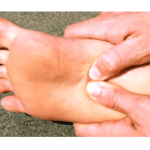Plantar Fasciitis
Plantar Fasciitis
 The band that runs along the bottom of the foot from your heel to the ball of the foot is called the plantar fascia. To find your plantar fascia, simply lift your big toe and the plantar fascia will typically “pooch” out along the arch on the bottom of your foot. The swelling of this band is our focus in this article and is called plantar fasciitis.
The band that runs along the bottom of the foot from your heel to the ball of the foot is called the plantar fascia. To find your plantar fascia, simply lift your big toe and the plantar fascia will typically “pooch” out along the arch on the bottom of your foot. The swelling of this band is our focus in this article and is called plantar fasciitis.
Plantar fasciitis is often caused by poor foot mechanics. If your foot flattens out too much the fascia may overstretch and swell and if your foot is very high arched the fascia may be too tight and ache. Additionally, many activities can injure your plantar fascia leading to irritation along it. Chronic pulling of the plantar fascia with concurrent swelling can lead to the condition commonly known as a heel spur.
Physical examination of the foot can reveal if plantar fasciitis and a good understanding of foot mechanics will often lead to a determination as to why it is present. X-rays are required to diagnose a heel spur.
Reducing the symptoms of plantar fasciitis can include many things:
- Ice. We recommend rolling a frozen water bottle under the bottom of the foot.
- Anti-inflammatory medications.
- Controlling foot motion with insoles and shoes.
- Starting a stretching program to reduce tension on the area.
- Anti-inflammatory medications.
- Controlling foot motion with insoles and shoes.
- Starting a stretching program to reduce tension on the area.
Occasionally plantar fasciitis and heel spurs require surgery but typically it can be addressed with conservative measures. We are very successful in treating this condition and we can often return patients back to a pain free active lifestyle in just a few visits. However, sometimes long term support of the foot is needed and the doctors at ETFA recommend custom orthotics in these situations
PLEASE NOTE:
The information contained in this article is not intended to provide advice for individual problems, nor to substitute for professional advice or care from a physician. For answers to specific questions concerning your personal circumstances, you should consult your physician directly.
